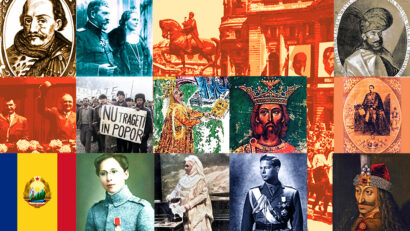Television and the society between 1960-1970
Between 1945 and 1989 the Romanian mass media was controlled by the Communist power. The process of gaining power over the media was gradual and took place at a fast pace. In mid-1940s the communists took control over the print media and the national radiobroadcaster, and when television emerged, everything was already controlled by the party-state. The Romanian press was mostly propaganda press but television, set up in 1957, was focusing more on social subjects and programs from the West. Journalist Ion Bucheru was the vice-president of the Romanian Radio and Television Corporation in the early 1970s. He had previously worked in the print media and he took his new appointment as a challenge.

Ștefan Baciu, 18.02.2019, 14:14
|
Between 1945 and 1989 the Romanian mass media was controlled by the Communist power. The process of gaining power over the media was gradual and took place at a fast pace. In mid-1940s the communists took control over the print media and the national radiobroadcaster, and when television emerged, everything was already controlled by the party-state. The Romanian press was mostly propaganda press but television, set up in 1957, was focusing more on social subjects and programs from the West. Journalist Ion Bucheru was the vice-president of the Romanian Radio and Television Corporation in the early 1970s. He had previously worked in the print media and he took his new appointment as a challenge.
In a 2003 interview to the Oral History Center of the Romanian Radio Broadcasting Corporation, Ion Bucheru explained that television was an investment that attempted to connect Romania to the world: “It so happened that in 1970 I was asked to work in the Romanian Television. It was the moment when the new television center in Calea Dorobanti had been finished. At the time, it was one of the most modern television centers in this part of Europe, equipped with state-of-the-art technology and the best quality equipment for that time. Unfortunately, the television center was not designed to meet future requirements. When it was designed and built, they envisaged a volume of about 50-55 hours per week for editing, production and broadcasting. The television center was ideal for this amount of work as it had been designed to be functional. It had large production studios, there were three of them and, at that moment, they seemed sufficient. But quite soon, the investment showed its limitations, given the television boom. I was assigned to take over the periodicals, the periodical programs, the social investigation programs, everything that was related to reporting, outside the News and Current Affairs department and the economic news and programs.”
Of course, the state television’s main mission was propaganda in favor of the regime. And Bucheru admitted to that reality: “A vice-president was expected to coordinate and set the guidelines for certain sectors, and of course to provide the political and ideological orientation of the programs. At that time, between 1969 and 1970, only strictly necessary cultural elements were included in the programs. Subsequently, the whole process started to collapse, at a fast and intense pace. When I started working in television, I was aware of the institution’s general orientation, it was the propaganda press for the party, just as the entire press was. The first item in the Constitution stipulated that all sectors of activity shall be managed by the party, especially the sectors dealing with the spiritual, cultural, political and ideological life. Everybody who worked in the Romanian press before 1989 actually worked for the party press, and that’s a fact! Of course, there was a big difference in the way in which this principle was applied at such publications as “20th Century” and “Literary Romania”, with the latter being a little bit more important as the magazine of the Writers’ Union.”
VF In the 1970s, the Romanian television was producing 117 programs per week, which was an impressive figure given its capabilities. However, its production was modest in comparison with that of the western public televisions. Even so, the Romanian television assumed a cultural and educational role. Here is Ion Bucheru back at the microphone: “The television’s film repertoire was quite good, although films accounted for a smaller percentage in the Romanian television’s programming than in the western televisions. It included quality films. The selection of film series was good, so Romanians were among the first big consumers of BBC-type TV series. What’s interesting is that Forsyte Saga was broadcast in Bucharest before it was broadcast in Paris. The French had not yet bought Forsyte Saga from the English when the Romanian television was already broadcasting it. The foreign languages program was set up in the 1970s, when I had a mandate to implement a program of teaching foreign languages by means of television.”
Social programs were very popular in the 1970s, when there was still some freedom of expression, which unfortunately vanished into thin air in the next decade. Ion Bucheru talked about two highly appreciated social programs “Spotlight” and “Social investigation’: “I was in charge of the Spotlight program, as representative of the institution’s leadership. At that time, this was a 20-minute or sometimes 25-minute program aired twice a week while Social Investigation was a 50-minute or even one-hour program at least once every two weeks. These two shows had become a social institution and the five people who were regularly producing the show Spotlight were like prosecutors who were doing their job on a public mandate. They used to receive personal letters, they were called by people who had lost all hope or by institutions that had exhausted all legal methods for solving their conflicts with private persons or other institutions.”
But, in the late 1970s, the Romanian television stated losing its popularity, its programs becoming more and more boring and focusing more on Nicolae Ceausescu’s cult of personality.
|






























